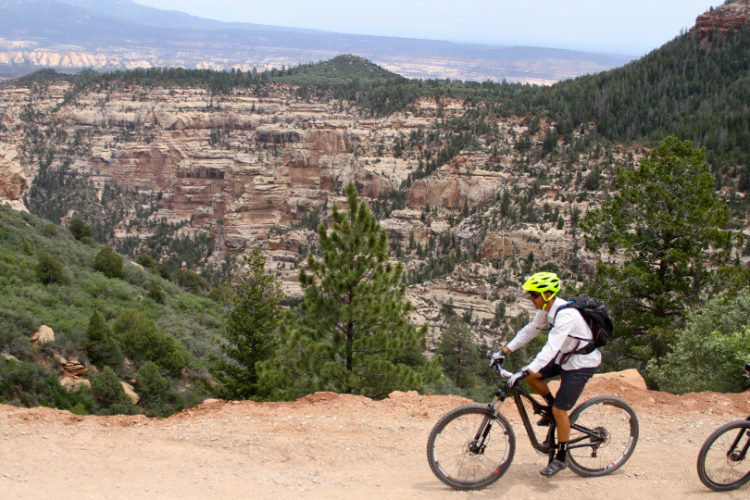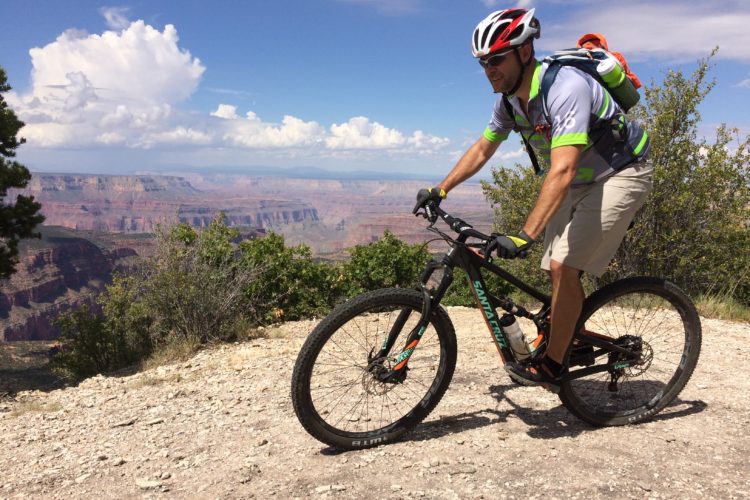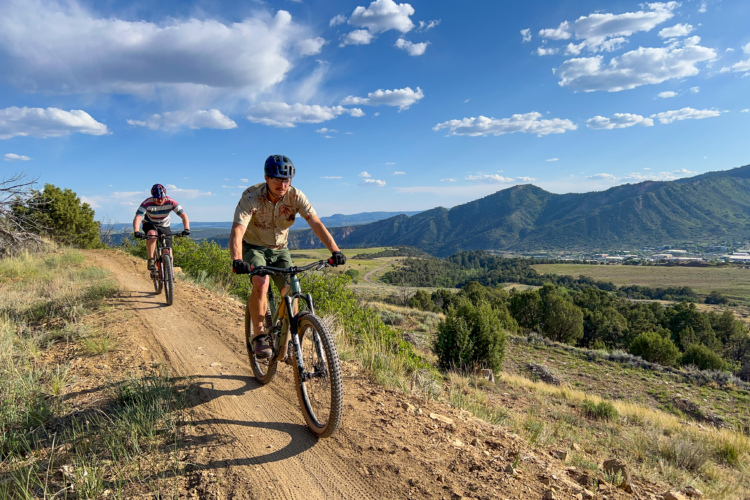
Driving away from the smoke and red-tinged angst of home in Carbondale—courtesy of Colorado’s Pine Gulch and Grizzly Creek wildfires—breathing became a little easier by the mile as we neared our Durango destination, and the charm of the western landscape worked its old magic on me. Leaning barns adorned with skulls, clear creeks and ochre mesas, sage and barbed wire—was this a Hollywood set? A landscape painting seminar? Nope, just Colorado.
“It could rain the whole time. That happened to me once. It was awful.” I was awakened from my reverie by MaryLyn’s abrupt reminder that this was to be no cakewalk. Five solid days of the hardest riding Western Spirit Cycling Adventures has to offer—Colorado Singletrack. Five days, 102 miles, 12,000 feet of climbing. The brochure fairly blinks in warning—“This tour contains some very difficult riding on narrow, steep mountain trails. A high level of skill and fitness is required to enjoyably navigate much of the route. There will be riding along steep mountain ridges with exposure to falls on the downhill side. We will be without vehicle support during all of the singletrack sections of the ride and medical help is far away.” Gulp.




The Colorado Trail runs 567 miles between Denver and Durango and passes through some of the most spectacular scenery in the Colorado Rockies. Split into 33 segments, this mountain bike trip tackled segments 25 through 28, starting at Molas Pass and ending at Junction Creek back in Durango, with the first day not on the Colorado Trail but on 18 miles of the swooping spectacular Hermosa Creek Trail. Veterans of this trip say that the Hermosa Creek day lets the guides suss out the guests, to make sure everyone (and their mount) is up to the task ahead.
2020 is Western Spirit’s 30-year anniversary. What a buzzkill. Co-owner Mark Sevenoff, a “guest” on this trip along with his 15-year-old son Kip, relayed the sad tale of celebrations and swag cancelled, along with the first half of the year’s trips. I asked him if there was any existential panic regarding the business.
“When two guides were diagnosed on two different trips with Covid, I was worried we would have to shut down. We participated in contact tracing with the help of the Utah Health Department and no one else on either trip got sick. The health officials said they don’t give awards for things like this, but if they did they would have given us an award for our Covid operating plan.”
On a particularly hot day after a long hard ride, my mind—my entire being—was laser focused on that beer in the cooler, the one with the arty label, snuggled into its own little snowbank. Faint tinkley music accompanied my reach toward the can, a halo emanating from its angelic head. Oooh, almost there…
“DID YOU USE THE SANITIZER FIRST?!?!?” erupted directly into my brainstem, the question bypassing my left ear entirely with its urgency. I retracted the offending appendage, stumbled backward, and the cooler lid slammed in an accusatory fashion.
Indeed, Western Spirit’s Covid operating plan turned our guides into slightly more diplomatic versions of everyone’s mother—“Did you wash your hands? Hey there! How’s about some hand sanitizer with that Clif Bar?” As keepers of the divine appetizer plates (gourmet cheese/crackers, dips, chips, fruit), steaming, aromatic dinners (hearty spaghetti, curried Asian chicken & vegetables, chicken Marbella and always a vegetarian option), and bacon-laced breakfasts, the guides held the ultimate power. Want food? Wash your damned hands.
“Oh, uh, yeah…I mean…no…I mean, I meant to? Yeah….” I felt small. I felt outed. I felt like I was the second gunman on the grassy knoll.
Chastened but recovered, beer at last secured, I asked Sevenoff if anything else in their 30-year history compared to the disruptions of the Coronavirus.
“Trips were cancelled on and around 9/11, but that was a short term shock compared to Covid. We are very lucky that people feel really comfortable going camping with us and our fall trips are nearly sold out. We know there are lots folks joining the cycling community right now and we are working to make sure they feel welcome, so we have big plans for next year with both Western Spirit and Outerbike.”

The call for coffee occurred every morning at 6:30 and was sure to arouse even the deepest sleeper (I do believe the guides took a kind of sadistic joy in the task—each experimenting with volume, tent-piercing pitch, best human air-horn impersonation). You’d think that two hours would be plenty of time to clear the fog, caffeinate, breakfast, pack your tent, bag, pad, etc., make your lunch, and get dressed, but somehow I always ended up with my hair on fire, right foot clad in a mountain bike shoe, left foot in a sneaker—Fuzzy Duds making my butt cozy when what was needed was the cold clammy squish of chamois cream and lycra to signal a state of readiness.
While other guests or guides were never far away on the trail, I did have several miles of riding—and sometimes pushing—to myself. These were times to take note of the ethereal views, to be enchanted by the beep, squeak, scratch and hop of the various wild creatures accompanying my journey. Hummingbirds zoomed in, eyed me warily, then zoomed out of view. In an unfortunate turn of events, I tangled with a grouse investigating my tread pattern. Feathers erupted from below. My attempts at avian first aid were thwarted because I could not locate the victim. I took this as a good sign that she was merely dented versus dead.

While admiring the gray and white wonder of another feathered friend, the Canada Jay—Perisoreus Canadensis—I lost myself in ruminations on the beauty and wonder of nature—not hard to do while staring out into craggy canyons laced with Aspen, fir, and red jagged rock forms tipping this way and that. Such a pretty, noble bird… Wait, what? This paragon of piety just dropped a gnawed fragment of chicken bone on my head as she flew over, then landed in front of me with the soiled edge of a paper towel she’d just plucked from the camp garbage. Turns out Perisoreus Canadensis is commonly known as the “camp robber,” and is a general nuisance. What a letdown. It was like discovering that Michelle Obama, that pinnacle of grace and poise, spends her weekends slaying the competition at hot-dog-eating contests.
Riding at this altitude, between 8,000 and 12,000 feet was hard on everyone. I kept hoping that an oxygen mask would drop down in front of me—I was certainly losing cabin pressure, and I would have no issue “affixing my mask before assisting others.” The group of 13—more than 50% women—were delightfully competent riders who all glowed with the joy of the views, the swooping smiley descents, and made for great fireside/dinner companions. Hailing from Flagstaff, Moab, Aspen, Spokane, Carbondale, and Oklahoma City, mountain biking once again brought together folks from all walks of life—teacher, doctor, photographer, solar salesman, planner, retail buyer, retired, adventure tour company owner.
And just to make good on the promise of the brochure, one of our group did in fact have a fall on the downhill side. While I pushed up toward the terminally elusive Blackhawk Pass on day three, a commotion ahead caught my eye. Dana was doing something acrobatic and elegant there on the side of the trail, though apparently not on purpose. A petite scream accompanied her dance while her bike cartwheeled off the side and landed the next switchback down in a twisted mass of rubber and carbon. Both bike and rider survived, the latter a bit shell-shocked for the next hour.
While true that this trip was no cakewalk, not for the faint of heart, it is an amazing way to experience the rugged epic-ness of the Colorado Trail without the added challenge of schlepping your gear. Or finding a campsite. Or cooking. Or cleaning up. My bags are not yet unpacked and I find myself scanning the Western Spirit website, looking for the next adventure.











2 Comments
Oct 6, 2020
Oct 5, 2020